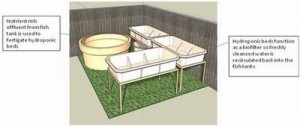By: Ramona Madhosingh-Hector
Local food movements are growing in number and the concept is driven by an interest in sustainable food production that allows local economies and cultures to thrive. “Local food” refers to food which is grown where you live. It might include food produced in your region from a farm or community garden, or even from your own backyard. The benefits of local food systems include:
- Energy savings due to reduced transportation and distribution costs
- Protection of the environment due to reduction of fertilizer and pesticide use
- Expansion of local economy by employing residents and pumping needed revenues into the local market
Aquaponic systems are attracting a lot of interest and are being regarded as a closed loop food production system since the inputs and outputs from one system is used in the other system. Simply defined, an aquaponic system combines a hydroponic unit with an aquaculture element.
An aquaponic system requires a careful balance of water chemistry so that the products in both systems will thrive. In practice, tilapia cultivation coupled with traditional hydroponic crops like lettuce, herbs and greens are well adapted to aquaponic systems. Tomatoes, peppers and cucumbers can also be combined with tilapia production but have much higher nutrient requirements. The key is to ensure that the plants and fish chosen for the aquaponic system can tolerate changing water chemistry. Tilapia is a very tolerant fish and low to medium nutrient plants like lettuce and herbs will survive environmental changes in the system. Tilapia, lettuce and greens are traditional products that have broad consumer appeal and the benefit of producing two products from one system is not lost on farmers!
The aquaponic system relies on two essential items – waste products of fish and the plant’s natural ability to filter. When the fish are fed, they produce waste which is then used to “fertigate” the hydroponic system. The plants’ filter the liquid fertilizer and return “biologically” clean water to the fish. The recycling of nutrients and water filtration is linked and offers significant cost-savings.
Aquaponic systems have the ability to improve self-sufficiency in food production since it integrates both plant and animal agriculture and provides the best example of a closed loop system where all the inputs and outputs are utilized. These systems are being used in the United States Virgin Islands and are on exhibit at Epcot Center in Orlando.
Aquaponic systems are sustainable food production systems because
- provide access to healthy food and enhance the local economy by producing multiple products
- reuse waste products, maximizes resource use (water), and promotes product diversity
- promote self sufficiency at the local level and can increase resiliency of a community
Resources:
 0
0

